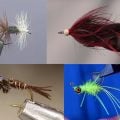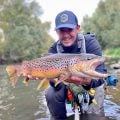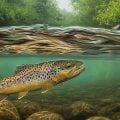How to Tie a Flounder Snack
Producer: tightlinevideo
I call this fly the Flounder Snack because that’s pretty much all I’ve caught with it over the last couple of years, that isn’t a bad thing. It’s actually based on Jeff Blood’s White Death steelhead fly, which, almost by accident, I found to work really well on summer flounder in the salt. As you’ll see at the end here, this fly has a wonderful jiggy motion like a Clouser and, also like a Clouser, rides hook point up so it’s less prone to snagging on the bottom. In addition, it’s very much a guide-style fly in that it’s relatively cheap and easy to tie.
The Flounder Snack starts with a super-reliable Mustad 34007 hook in size 1. It’s important that the hook be really well secured in the jaws of your tying vise, as a good amount of thread tension should be used while tying.
A white rabbit Zonker strip is what really brings this pattern to life. I’ll take a full-length strip and, with the fur canted rearward, measure off a full hook-length of leather hide, and make a little separation there. With the fur facing forward, I’ll then stab the hook through the hide at this point, then work the Zonker strip up into the hook bend and re-secure the hook in the vise jaws. Pinning the Zonker strip back with a hair clip will help to keep it out of the way during most of the tying procedure.
For thread, I’ve loaded a bobbin with a spool of red UTC 140. As I said earlier, wrapping with a good bit of thread tension is important, so I’ll crank it up a bit on my Rite Bobbin. Get the thread started on the hook shank, leaving a little space behind the eye and, after taking a few wraps rearward, snip off the excess tag. Advance your thread forward, so it hangs at about the midpoint of those wraps.
Large sized, pearl chenille is used to form the body of the fly, a 3-card width length is a tad long but a good place to start. Strip a small amount of the fuzzy stuff off to expose the string core at one end of the length. Then, tightly bind the chenille to the hook shank, all the way back to the start of the hook bend, with tight wraps of tying thread. Wrap back up to a point about 2 eye-lengths back from the rear edge of the hook eye.
Pearl-colored, large-sized dumbbell eyes are used to “Clouser” the fly, “Clouser” can be used as a verb, right?! Anyway, place one of the eyes into the hook eye and then move your tying thread to the back edge of the rear eye. This measurement is pretty key to getting the fly to behave correctly when fished.
Use a few cross wraps to begin anchoring the eyes on top of the hook shank, and perpendicular to it. Follow these with yoke wraps, which go over top of the eyes on either side of the hook, but under the hook shank. Chase the yoke wraps with circular flat wraps below the eyes but above the shank to draw all the previous wraps in tight. This is the best sequence I’ve found for securing dumbbell eyes. End with your tying thread about halfway between the front edge of the dumbbell eyes and the back edge of the hook eye.
Get hold of the chenille and start making touching wraps up the hook shank with it, preening the frilly stuff back as you go. When you reach the dumbbell eyes, do crossing wraps between them to fill in the space. Then, anchor the chenille in front of them with nice tight wraps and snip the excess chenille off close.
Coax any forward-pointing, wonky frillies back and take thread wraps to hold them back. Flip the fly over and snip the chenille off close on the underside of the fly. This will allow the rabbit Zonker to lay flat.
Remove the material clip and pull the Zonker strip forward, over top of the freshly shorn body. Create a space on the strip above your tying thread and use nice, tight even-pressure thread wraps to really lock the Zonker strip down. When you’re satisfied the strip can’t pull free, lift up the excess forward-pointing portion and snip it off as close as possible. Once again, trim away any wayward fibers.
Starting at the back edge of the hook eye, take touching rearward thread wraps to cover up the materials below and to begin forming the head of the fly. As an extra step to clean up the head, I’ll coat a bit of my thread with Veniard’s tying wax, then take nice tight wraps rearward with the coated thread, before leaving it at the back edge of the head.
Pick up your whip finish tool and use it to do a 5 or 6 turn, back to front whip finish, seat the knot well and snip or cut your tying thread free. Although not essential, I’ll do a little trimming of the chenille to taper the front of the fly and to remove anything obscuring those big bright eyes. It’s extremely important to get hold of some head cement or UV cure resin and thoroughly coat the entire thread head of the fly. This will further insure that the rabbit Zonker cannot pull free.
Yeah, it is a good bit different from a White Death but, for me, that really was the initial inspiration for the pattern.
As you can see here, the fly looks just great underwater and the jiggy motion imparts a ton of movement to the Zonker strip back and tail. The fact that the fly is “Clousered” with the hook point up means that it’s less likely to get snagged, even when dragged along the bottom.
How to Tie a Flashback Pheasant Tail
How to Tie a Flying Squirrel Nymph











